#Medieval Food
Text
Medieval Mac and Cheese recipe
(As demanded by yall)
Macrows
“Take and make a thin foil of dowh, and kerve it on peces, and cast hem on boiling water and seeth it wele. Take chese and grate it and butter cast bynethen and above and losyns. and serve forth.”
-> from the ‘Forme of Cury’ p. 46, compiled about A. D. 1390.
The more readable interpretation as set down in Cariadoc’s Miscellany is as follows:
Ingredients:
2 cups flour
⅔ cups cold water (approx)
3 cups grated cheese (approx). They used swiss and parmesan.
4 tablespoons butter (approx).
Knead flour and cold water into a smooth, elastic dough. Roll it out thin and cut into broad strips (1”-2” wide). Boil it about 5-10 minutes (until tender). Put it in a dish, layered with grated cheese and butter. You may want to heat it briefly in an oven (although the recipe does not say to do so).
Happy cooking!
#lemme know if you want more medieval recipes or links to medieval cookbooks btw!!#history#medieval food#mac n cheese#medieval reenactment#medievalcore#historical reenactment#medieval#14th century#i’ll be on my merry way now
475 notes
·
View notes
Text
Medieval Food - Let's Talk
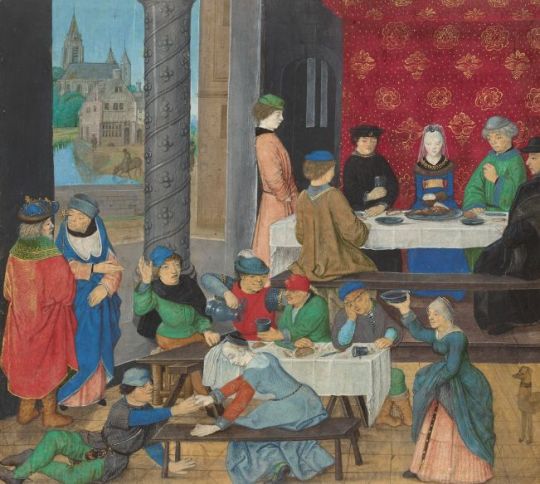
You know what? One week later and I am still fairly annoyed.
First of all: Yes, I am very much aware that technically one should not take MatPat too seriously and that for the most part if anything the “XY Theory” channels are just mild entertainment… But let’s face it: There are thousands of kids watching this, who are gonna take it seriously. And even a lot of adults, who do not know better.
So, as this is a topic near and dear to my heart and also a topic that the internet just throws around so much misinformation around on, let me talk a bit about Medieval Cuisine.
The Offense
Let me start with the thing that annoyed me so much, even though the issue is not so much about the issue at hand and more about the missing context in this one. Last week the @gametheoreoy sister channel Food Theory uploaded a video on Medieval Cuisine. While some of the information in there was good and included some important stuff that a lot of folks get wrong (like the fact that tomatoes, potatoes and maize were foods that came from the Americas and hence were not around in medieval Europe), the thing that annoyed me most about the video was… that MatPat and team absolutely ignored the fact that the place in question, medieval "Spain", was in that timeframe under under Black Muslim rule. In fact, there was technically no “Spain” at the time in question. Not as we imagine it today. Instead there was Al-Andalus (or Andalusia, how we know it today) and Leon-Castille. While the latter was Catholic, yes, the former was Muslim.
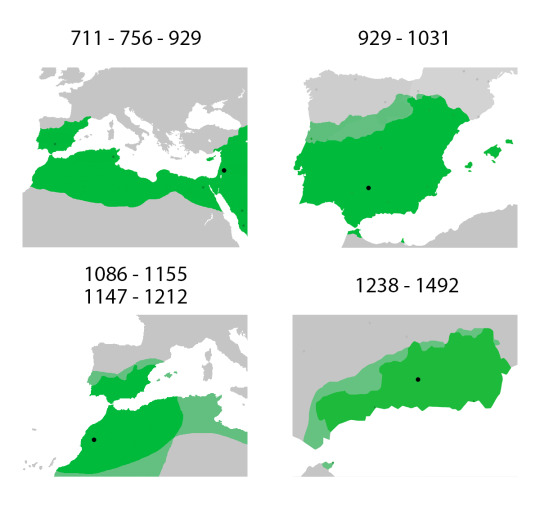
This really makes me angry, as it once again just plays into the misconception that medieval Europe was all white and Christian. Which it was not. For most of the medieval period, large chunks of the Iberian peninsula were under Muslim rule, which was also a reason that a lot of persecuted minorities – for example Jews, some Sinti and Romani people and also followers of Christian sects, that were not Catholic – fled there, as at that time Muslim rulers tended to not persecute those minorities, while the Catholic church did.
Now, it should be said that under Muslim rule, nobody who was not Muslim was forced to follow Muslim religious law, as not eating pork. But from what we know there was a lot less pork consumed on the Iberian peninsula at the time, than elsewhere in Europe. Instead, lamp, veal, dear and poultry were the more popular meats.
And I am sorry, MatPat, but talking about this part of Europe in the medieval times without speaking about Muslim rule is just a super bad look. Because it erases some important history.
While we are on it
But while we are on it, allow me to talk about Medieval cuisine, because bow, howdy, do people get this topic wrong.
For reference: No, I am no historian. But I am an autistic person, who spend a couple years hyperfixating on the history of food and henceforth getting annoyed with a lot of books, movies and the like, whenever they are depicting food in the medieval times.
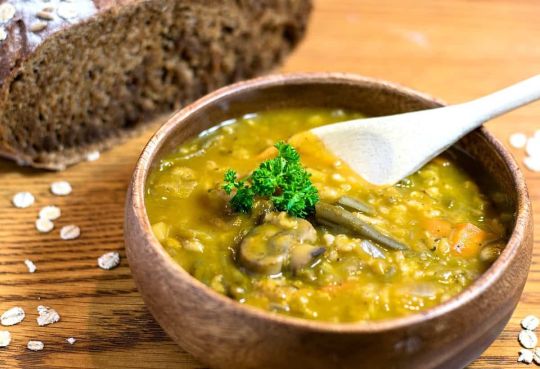
Some things that I have seen in those contexts are, obviously, the tomatoes, potatoes and maize. But especially potatoes. Oh, boy, howdy, do people love depicting medieval folks eating potatoes. Maybe not surprising, given that the potato is in fact a main stay in modern day European cuisine. Also, obviously, the potato has still the reputation of a pauper’s food, which then easily combines with the common misconception of “people in medieval times were very poor and ate very poorly”. But, again, the potato would not reach Europe until probably 1519, though it would still be a while until people figured out how to eat potatoes (given that the green parts of the plants are in fact poisonous). Same goes for tomatoes, all sorts of peppers and again maize (corn, for the Americans).
Meanwhile people would go up to me and tell me seriously that “people in the medieval times did not have noodles”, which is… ridiculous, given that noodles and all sorts of pasta were around in Europe since ancient times. Even the old Greeks and Romans ate noodles, just not in those many fancy forms we know today. For the most part in medieval times people ate some sort of ribbon noodle, something we might call ravioli today, just noodles cut into square and something that was called lasagna, though it did not resemble today’s lasagna much. But noodles there were.

Another food that people do not associate with the medieval times, even though it was very much around in Southern European places, was rice. Other than the Americas, people kinda always knew about Asia and were trading with them. Even in Roman times. Which lead to the Romans actually cultivating a strain of rice, that did well enough in Europe. Now, while rice was not a common food in medieval Europe, it was certainly around.
Probably the weirdest thing, someone claimed about medieval food, was, that there was no “stew” around in medieval times, because it was “too complicated for the people back then”. You know, stew, the food where you basically just put a lot of different stuff into one pot and cook it… “Too complicated”. Honestly, I do not know what to say about that. Stew was not only around, but also very common. Especially as a lot of people did not have actual kitchens and were instead cooking their food over their fireplace, that often enough would only allow for one pot.
The thing about meat
One thing that MatPat gets mostly right – though, again not for Al-Andalus/Spain, because things were different there – is the bit about meat in the middle ages, though while he says the right thing here, he kinda misses a bit of context.
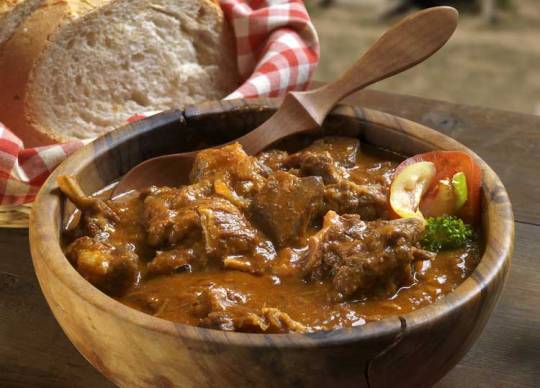
Meat was expensive in medieval times. Why? Because in a time before factory farming it was expensive to raise an animal. Some of you might’ve heard about “economy of scale”, which basically just says, that the more of a thing you produce, the cheaper it will become. And yes, this very much is true for factory farming. (Note: Factory farming is evil, simple as that. No living being should be treated the way, we treat those animals on factory farms.)
So, yes, without factory farms it was just more expensive to make the meat. Which was especially true for smaller animals like chicken. Especially as medieval chicken breeds were smaller than those chickens we see today.
Hence, for a lot of people, meat was just not a thing that they could eat more than once or twice a week. Or, more realistically, a lot of meat was eaten at once, when an animal was slaughtered, while only parts of the animal that could be conserved would then be served over a longer period of time.
It should also be noted that at least Christians tended to use all parts of the animal upon death, including blood and organs. (Muslims did not, as stuff like the blood is not halal.)

Now, one thing that should be noted, is, that most animals that were kept, were kept for multi purposes. Chicken lay eggs. Cows, sheep and goats give milk, with sheep obviously additionally providing wool, making them a very well-beloved animal in medieval times indeed. Horses you can ride. And yes, the pigs were useful, too, as they disposed of garbage, which was why in a lot of places you would just have pigs roaming the streets to take care of that.
Which brings me to the thing, a lot of folks do not want to hear, but… yeah, no, we have sources that tell us that medieval folks did at least also eat their dogs, when those were too old to help on the farm. We do not know how common this was, but we know that it happened. (Just as a note to the white folks getting all snooty about some Asian cultures eating dog meat.)
Of course, game was not kept but hunted. And yes, some people might go out to hunt when they were hungry for meat, but technically speaking it was illegal in many parts of Europe, based on the fact that game living in an area would belong to the nobility owning the land. Now, how those laws were enforced depended a lot on the area and how much game there was. But technically it was considered as such.
About vegetables
Having established that tomatoes, bell peppers, chilies and potatoes were not around in medieval times, this leaves the question: But what was around?
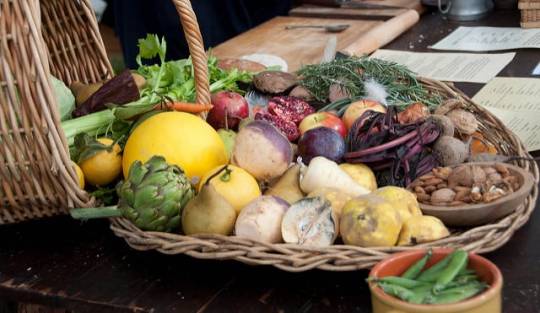
Well, two stable foods we still eat a lot today were definitely around: Carrots and peas. Especially peas were rather cheap and hence were eaten a lot. There was also at least one type of bean around in medieval Europe. Yes, only one. But horse beans were around in medieval Europe and were in fact eaten. Lentils were also quite popular.
Other than that, we also know of turnips, beets, cabbage, kohlrabi, onions and garlic being eaten. But that is not all, as there were several other types of vegetables, that are not around today that much, having been eaten. Especially a lot of root vegetables, like celeriac and parsnip for example.
But also fennel, that tends to be rather unpopular with modern people, was very much around and eaten.
One other vegetable that had some types around in Europe, was the pumpkin. Specifically, the gourd, that originated from Africa, but was cultivated in Europe rather early on.
Also there was a lot of salads and herbs, that also might be eaten as a form of salads.
But how do we know about medieval cuisine?
Another big thing that people tend to be kinda confused about, is, how we know what medieval people ate. Because, yes, at the time books were very expensive and a lot of folks could not read or write. While I will always harp on about the point that we greatly overestimate the number of completely illiterate folks in medieval times, as a lot of people were at least able to read a bit and write down the results of the harvest. But… written language was definitely not the main method of conserving information. Hence, there are only a handful of books around, that are primary texts and are collections of recipes. Most of them originate from noble or royal households, where the chefs would write down what the lord and lady of the house favored.
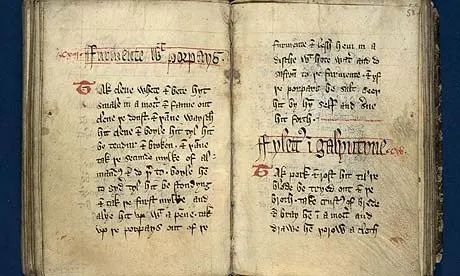
Other than that, we have a couple of letters, in which people shared their recipes.
But a lot of what we know “existed” is more from mentions within letters and diaries of “today I ate this and that” and historians then trying to figure out what that could have been, based around what we know about the foods that we know were available to the people. At times we also have findings of preserved foods. Now, of course those foods did not preserve for hundreds of years, but we can do chemical testing on what remained and hence figure out what originally had been preserved.
And of course there are pictures we have, that depict foods.
What we thankfully do have, is well documented harvests and things like ledgers from the likes of butchers and farmers based on the stuff they might have sold or given off as a form of taxes (which were often paid in goods, not coin). So, we know at least the raw materials and what might have been available.
And yes, there are also those kind of food that we know where around at ancient times and that are around in some form today. So, we can gather that they have been around the entire time. A good example for this are garlic bread and a version of pizza. We know that even in ancient times people baked bread with garlic butter and bread with vegetables, meat if available and cheese on them. It does not take a genius to figure out that bread with molten cheese on it, is pretty awesome.
Something I want to note as well is, that those recipe books we do have basically all originate from France, Germany and England, with two also originating in Italy. Medieval Europe was more than those four places. Which leads to my issue that a lot of folks tend to ignore that there were cultural differences and that, yes, we kinda are forced to rely on finds and maybe letters. (Believe me, as someone who writes about medieval Wallachia for my fics, it is a pain in the butt.)
But what did medieval people eat?
So, let me overgeneralize a bit. Because again, what you would eat in those times was dependent on where you were living and how wealthy you were. Richer people and nobility would eat meat a lot more often than less wealthy folks.

Generally poor folks would most of the time have some form of porridge for breakfast. That was: Oats cooked in water. If they could afford it, those might be cooked in milk. Maybe with honey. When it was the season, there might’ve been some fruits or nuts in there, too. But most of the times just oats in water. As oats were one of the cheapest forms of corn, they were good for that. Some people might use other corn like rye or barley softened in water as well.
If you could afford it, you might have head bread as well. For most folks it was a rye bread or rye sour dough, because rye was cheaper than wheat. This bread would not be eaten in slices, but rather eaten together with whatever was available. Maybe together with cheese. Maybe dunked in stew or soup. (Which, by the way, leads me to the fact that most taverns only served stew or soup with bread. Not “nice pork grilled over a fire” as we so often see it depicted in media.)
And yes, as a main warm meal there was stew and soup – vegetable soup for the most parts, because again: Meat was expensive. When there was meat in the soup, chances were, that It was all sorts of meats and in fact it was more likely that it would be hare or sheep, rather than pork or poultry. At times the same stew would be eaten for more than a week, with just new stuff being added, whenever it was half-empty, so you might actually get a mix of meats in there. (This was, again, also quite common in taverns, where people might just bring some stuff they had lying around and add it to the so called “everything stew”.) While it might sound disgusting to us today, it actually allowed for pretty deep flavor profiles.

Again, poor folks would often not have a dedicated kitchen or stove and rather would prepare their food over the fire place that was also used to heat the house. Which would lead to a lot of “one pot meals” as we would call it these days. And if there was meat, it often would be prepared as a larger chunk, instead of small cuts being prepared in a pan.
Of course, those were things that rich people could afford more easily. Though this did not necessarily mean nobility, but also folks like tradesmen and the likes. Who not only might have a dedicated kitchen, but also some maid to cook for them.
And there was of course the thing about spices: Medieval cuisine for the most part did not use spices, but only herbs. Because spices mostly originated in North Africa and South Asia and hence had to be traded over long distances. This would make them rather expensive, so many folks were not able to afford them. (Again: the entire colonialism affair started, because everyone wanted spices, while the Ottoman Empire controlled the spice trade.) This does, however, not mean that spice heavy recipes were unknown to medieval folks. They were expensive, yes, but we have both archeological and written evidence from meals, we would today call “curry” being prepared both in England and France.
Milk, no matter what animal it came from, would often be turned into some form of cheese, because most animals would only give milk, when it was season for their young. So, making the milk into cheese was a good way of making the milk last for longer. And yes, lots of folks knew how to make cheese. So, cheese was something that was often enough served to the side. Though dairy as well was not as common as it is today.
Wheat, again, was expensive. So, bread and other food based around wheat was more expensive than rye. Often wheat would only be enjoyed by rich folks and men of the cloth (meaning church folks). And only very rich people could afford white flour based food, while everyone else was eating food based around whole grain flour.
And yes, for the observant ones it should be obvious: Poor folks were eating a lot more healthy, than rich people were. Which led to interesting stuff like the fact that poor people often did not suffer from dental problems, even though dental hygiene was not yet a thing. Simply because they were eating better and less sweet.
Oh, and also: Most people would in fact drink alcoholic beverages (though with a lot less alcohol content than what we know today) instead of just pure water. Why? Well, because chances were, it made you less sick. And yes, also it tasted a lot better than stale water you got from a well. For most folks that was beer or ale, for richer folks wine or at least thinned wine. Except, again, in areas where there was a Muslim majority, because those obviously would not drink alcohol, so there would often be fewer breweries.
Medieval people did not eat badly
Now, let me make one thing clear, because it is a thing I tend to get annoyed by a lot: No, medieval people did not eat badly. Which was the other thing that annoyed me about MatPat’s video, given that the title card was “Medieval Food SUCKS!”, which… no, it doesn’t. It didn’t. It was different, from what we eat today, yes, but it was not bad food.
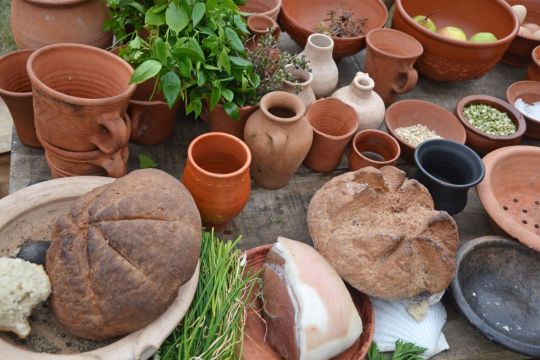
See, it is something that a lot of modern first world folks (especially white folks) are just too picky eaters and with that also kinda wasteful. We will only eat certain bits of dead animals, will not eat a lot of dead animals that are gonna die either way (heck, we have laws against eating certain animals, that are not based in any other reason but people’s emotional attachment to those animals), will not eat many vegetables that would be easier to grow and so on.
And sure, the fact that there was so little spice in medieval food, that makes it kinda… meh. But herbs can be used for those purposes, too. And yes, they can make things rather tasty indeed.
And yeah, I kinda bemoan the way we consume food today. Part of it has a lot to do with capitalism, of course. With the fact that we just do not have the time and means to grow our own food and the fact that of course, that to keep food prices low (which is necessary) but also keep the profits high, food production is plagued by all sorts of inhumanities. Be it slave labor, violence again humans (just look into the history of Chiquita or Dole) and of course the inhumane ways we keep animals.
A lot of folks do not even know how to prepare their own food properly. And do not know where it comes from. And as someone who identifies with the solarpunk culture, I just wish we could change away from that.
So, yeah, Let me just say: The MatPat video was just not that good and ignored an important part of history. Also, a lot of media depicts medieval food culture wrong, leading people to have all sorts of misconceptions about it.

Currently I am writing a fanfic about medieval cooking based around the Castlevania fandom. You can find it on Ao3! Though, yeah, the characters here are rich enough to eat spices.
And if you liked this little rant essay, maybe consider leaving me a little something on Ko-Fi!
#History#medieval cooking#medieval food#food theory#historical cooking#medieval europe#learning#education#middle ages#spain did not exist in the middle ages#white washed#white washed history#long reads#rant post#food history
114 notes
·
View notes
Text















𝔑𝔢𝔬𝔭𝔢𝔱𝔰 𝔐𝔢𝔡𝔦𝔢𝔳𝔞𝔩 𝔉𝔬𝔬𝔡: 𝔣𝔯𝔬𝔪 𝔱𝔥𝔢 𝔏𝔞𝔫𝔡 𝔬𝔣 𝔐𝔢𝔯𝔦𝔡𝔢𝔩𝔩 🏰
#neopets#neopet#neopets food#medieval#medieval food#medieval times#turkey legs#berries#bread#breadcore#2000s internet#2000s web#00s
49 notes
·
View notes
Text
Cooking in Stoneware Pots
For my elevation, Órlaith and Gytha got me a stoneware cooking pot. This is a pot made of actual stone - soapstone - and of a kind widely used in the Middle East in the era in which al-Warraq was writing. I have finally gotten a chance to try it out, since Pen & Sword provided me with an event where I had room on the fire and wasn't under any pressure to produce food (I was cooking a couple of Arabic stews, but they're things I know well).
The most immediate thing, which is completely obvious once it's pointed out, but which I didn't know before, is that a thick stone pot (the walls are not quite an inch thick) retains far more heat than a cast iron pot, which retains a good bit more heat itself than a stainless steel one. Nonetheless, if you take a cast iron pot off the heat, it will stop boiling in seconds. The stoneware one just keeps on boiling, and will do so for a good 2-3 minutes.
This makes sense of a number of instructions in period texts where pots are removed from the heat, and also makes sense in the context of serving the food in the cooking pot - the food will stay hot for much longer than it could in any serving dish. There's usually an instruction to wipe down the pot to remove soot and so on, so there's no doubt that it's the actual cooking pot.
Second, and this will need more trials, the food tasted different - the sweetness of the onions was far more evident. Also, there's a separation that happens when the stew is ready; you can see oil and other liquids apart from each other at the edges of the pot. This happened sooner, by far, in the stone pot. That might be because it's smaller, of course. Further experimentation needed.
#sca#medieval food#medieval cookery#medieval cooking#medieval arabic food#al warraq#soapstone#stoneware#more research necessary
22 notes
·
View notes
Text

made some green pea pottage, following a 14th century recipe from the book 'curye on inglysch'
though i left out the saffron and added a green, sour apple, because i love the taste of onion and apple together
very good
and yes i am using my medieval bowl and spoon because i cant wait for the big reenactment event in three weeks pssstt
#personal#medievalcore#medieval food#ignore the cup that one is not historical#but i didny feel like getting my jug out
29 notes
·
View notes
Text

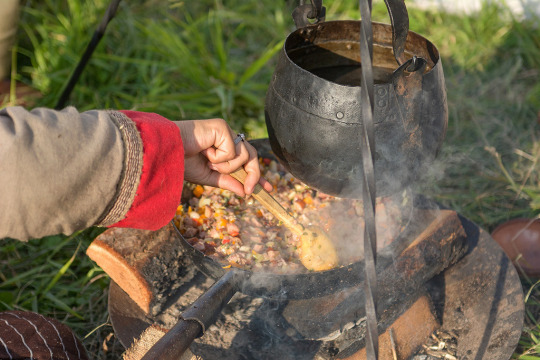

⊱ɱε∂เεѵαℓ-ƭɦყɱεร⊰
#medieval#medieval cooking#medieval food#medieval times#medievaltimes#rustic food#rustic#rustic cooking#primitive#primitive cooking#outdoor cooking
21 notes
·
View notes
Note
Do the Fair Folk have jobs? Do they have their own currency? Do they have their own government?
Of course they do.
Whatever needs to be done, they'll do it. For example, if someone decided they wanted to have some Frytour blaunched (a kind of almond-filled pastry baked in honey and wine) they would need to have someone to grow and harvest almonds, to grow ginger, to grow and process sugar, to pan for or otherwise obtain salt, someone to keep bees and to obtain their honey, wine makers, someone to obtain the oil used in cooking, and of course someone to package and send off all of those goods, someone to transport them, someone to receive them, and if the Faerie in question wasn't making it themselves they would also have someone to actually make the pastry. That isn't even taking into account all the labor involved in making just the pastry dough. For something like that you would need butter, which necessitates the keeping of dairy cows or goats. You would need eggs, which means that someone needs to keep whatever kind of birds the eggs are from, or at least go out and collect them. Flour would require tilling and planting and harvesting. And saffron, if you're inclined to be traditional, would need to be gathered as well.
The Fair Folk, if they want to continue playing their games of human courts and societies, must have people to do all of those things. However, unlike our world, the folk do not necessarily need to eat. At least not to live. But eating is nice, and they would delight in grand feasts and an extravagant variety of dishes and desserts.
Some of these they used to gain from humans, as offerings. But there is much they would have had to obtain for themselves, by stealing, or by hard work. Yet unlike human society, the Fae cannot be forced into such a position unless it is what they themselves wish to do. No threat of death or starvation, and an assured eternity of doing whatever they wished, what could possibly force them to live a life they didn't want?
Many of these fae do the work as a hobby, something they enjoy for the doing of it. The beekeeper likes the bees, they sing together in the soft evening light, and the bees trust them more fully than they would their own. Winemakers have perfected their work over centuries of effort, cultivating it far beyond a mere process to an artform.
Assuredly there are many jobs that the fae might do. Some might carve wood into furniture or toys or mysterious wardrobes that lead to places they shouldn't. Others might make shoes or clocks or wind chimes. Whatever it is they want to do, they simply do.
Those in the courts will play their own games, games of lords and ladies and power, games of kings and governments. And as long as the rest of the folk are content, then things will remain. But the memory of the Fair Ones is long, longer by far than humanity's. They are not easily preyed upon.
As for coin, no. I do not think the folk have coins of metal such as humans have used throughout the ages. Yet there is much to trade that they value. Promise or deal, unbreakable once made. A memory of their own or from another. Anything can be traded. Moonlight, starlight, wind from the hilltops. Do you sell fruit from a country that no longer exists? Or buy only last edition poetry novels which will never be printed again? Or trade in beautiful fabrics of your own work? A name dealer? A seller and buyer of souls? What are you willing to give for what you want? What are you willing to take in order to give what is yours?
Sometimes, if they wish to facilitate the game, or merely enjoy the work but have little use for the fruit of their labor, they might simply give it away, happy that it is being put to good use. For them, that is payment enough.
Humanity is so concerned with buying and selling, so worried about the worth of things. The Folk, the Faeries, they are more often concerned with the enjoyment of life, and that to them is of the most importance because they have an eternity of it to live. So they find things to do that they love, that are meaningful to them, that bring laughter and song.
So that you too might find something of their joy, here is a recipe for Frytour blaunched.
INGREDIENTS:
Finely ground almonds
Ginger - the powdered spice, not the fresh root.
Sugar
Salt - use to taste.
Pastry dough
Oil
Honey
Wine - red or white & slightly sweet.
DIRECTIONS:
Mix almonds with sugar, ginger, and a little salt - this should be a sweet, slightly spicy blend. Roll out the pastry dough.
You may now make the pastry several different ways: by cutting out circles of dough, placing filling in the middle, and folding into a half-circle; by cutting out circles, squares, or triangles of pastry, placing filling in the middle of one piece and then covering with another piece of dough and sealing the edges; or by making small stuffed squares or rectangles, egg-roll style. In any case, make sure the edges of the pastry(ies) are securely sealed.
Fry the pastry(ies) in hot oil until lightly browned; remove from oil and let drain. In a pot, bring the honey to a soft boil, then reduce heat. Skim off the scum as it rises. Add just enough wine to make a thick sauce.
Thoroughly coat the pasty(ies) in the wine sauce, then place on a baking sheet. Bake in a hot oven for several minutes. The pastry(ies) may be basted with additional sauce during baking or immediately afterward.
#fairy#fae#faerie#fae folk#fair folk#fae culture#faerie government#faerie currency#faerie jobs#pastry#baking#medieval food#medieval recipe#baking recipes
69 notes
·
View notes
Photo


Menjar blanc (which in Catalan simply means “white food”) is a Catalan dessert made of almonds, rice flour, lemon peel, cinnamon and sugar. It’s eaten cold, so it’s perfect for summer.
This recipe has been enjoyed in our country since the Middle Ages, as we see in Medieval books. Nowadays, it’s very typical from the south of Catalonia, but it’s also eaten in other parts of Catalonia, the Balearic Islands, and l’Alguer.
Photos from catalunyacuina.com and patatasanta.com.
#menjar blanc#menjar#food#dessert#almond#cinnamon#sweet#summer desserts#desserts#medieval food#cuisine#almond milk
156 notes
·
View notes
Text
Was Medieval peasant food as depressing as we imagine? From simple dishes like bread and fish to treats like pies and sweets, this is everything you need to know about Medieval peasant food.
#Medieval Europe#medieval peasant#sorrel sauce#ancient recipes#food#historical cooking#medieval food#ancient#history#ancient origins
24 notes
·
View notes
Text

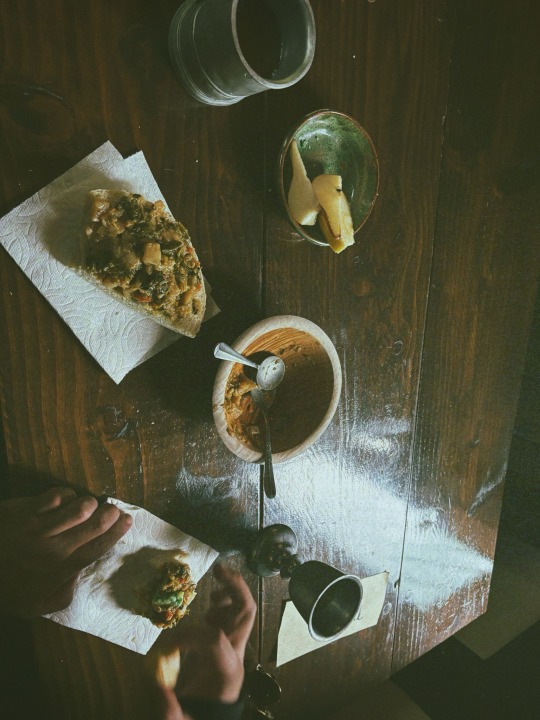
eating like kings 🏰
#medieval#medieval festival#medieval food#history#historic food#tudor era#aesthetic#dark grunge#dark academia#washington
4 notes
·
View notes
Text

Meat Skewered Meat
What is better than skewered meat? Why, meat skewered meat, of course!
[2,500 NP]
14 notes
·
View notes
Text
Sigginstown Pottage
One of the most basic dishes of the medieval period - and in any culture, pretty much - is the pottage. This is basically "stuff cooked in a pot with water", which is a very broad definition. This particular "recipe" is one that I think is straightforward enough, uses common enough ingredients, and is palatable enough that it was almost certainly made in pre-Norman Ireland (by statistical inevitability, if nothing else). I've given it the name of "Sigginstown Pottage" because I first made it at Sigginstown Castle, and it's useful to have a name by which to refer to it.
1 smoked pale ham, chopped into 1cm cubes
2 onions, chopped (or some celery, also chopped)
2 leeks, roughly chopped
6 carrots, roughly chopped
c. 500g pearl barley, bulgur wheat, or other likely whole grain
Water to cover
Put everything above into a pot, and simmer until the meat and grains are cooked. Taste and season with some black pepper if needed. Serve hot.
Some observations: Onion is the more "authentic" between it and celery, but both were available. I've been going easy on onions lately due to food sensitivities. Leeks are absolutely a period Irish food, and possibly close to a staple; they're mentioned a fair bit in texts.
The pale ham (I don't know if this is known outside Ireland; it's a small chunk of cured ham, which is pretty salty) provides enough salt that you shouldn't need to add any more. The smoking is pretty solidly attested in period by the number of bones we see with holes for hooks.
You'll see some people claiming that carrots only arrived in Ireland with the Normans, but there are carrot seeds in the archaeobotanic remnants from Viking Dublin, and there's an old Irish word, meacon, which denotes tap-rooted vegetables like parsnips and carrots, but is usually used for carrots. So I'm pretty confident in including these.
The end result is a very solid, stick-to-the-ribs kind of stew; good eating for colder weather or when you've been doing physical work. I've only ever cooked it in cast iron, and it turns out that if you leave the leftovers in the pot overnight, the combination of whole grains and iron results in a horrifically grey stuff, which still tastes fine, but looks absolutely awful. So eat it hot, and don't leave leftovers.
#pre norman ireland#pre norman irish cuisine#pre norman irish food#irish food#irish medieval food#sca#medieval cooking#medieval food#viking ireland#norse ireland#sigginstown#sigginstown pottage#barley#carrots#leeks#onions#ham#cast iron
41 notes
·
View notes
Note
This might be a stupid question but do we have historical evidence of peasant sandwiches because I feel like eventually somebody must have thought ‘hey wait a minute. This sheep is good. This bread is good. What if I just’ and then mixed them
Maybe more like. Stuffing the meat IN the loaf in most cases but I consider that a sandwich for the sake of argument
Well, the sandwich as we know it was invented in the 18th century
thing is, especially in a lot of places in europe we dont really put a second piece of bread on top, we just put stuff on a bread (e.g. Aufschnitt/Belegtes Brot/Brettljausen in German speaking countries, smørbrød/smørgås in Skandinavia, Butterbrot in Russia etc), and the theme of putting stuff onto bread is as old as bread itself
and in medieval times they had pies, not the sweet kind but just savoury food baked on a pie, dough being the casing which was not always eaten, and e.g. the cornish pasties which also originate in medieval times are similar to that concept. you can take those with you when you go places
so instead of putting stuff between bread, they cooked the things in dough from the start
and if you have e.g. lunch outside in the field, you'd have bread with cheese and sausage and stuff, which you can easily take with you and just eat together, no need to put it between bread. slice a piece of cheese off, put it on your piece of bread and bite it off, easy. (still how we eat it in austria)
that being said, there is a recipe in 'Das Buoch von guoter Spise', 1350s Würzburg, where they put an egg-pear-apple mix, between two thin slices of bread and fry it (recipe 10)
you also usually (at least we see it in art) have bread with any food, so if you cook sheep you can just slap it on and take a bite
i hope this kind of answers your question!
20 notes
·
View notes
Text
Medieval cooking basics - This article explains how to add Gold Leaf to your presentation to create a stunning and luxurious presentation.
#medieval food#food history#sca#foodblogger#Giveitforth#gold#history#cooking#foodstagram#archaeogastronomy#historicreenactment#recipes#medieval#yum#tasty#foodlover#ediblehistory#culinaryhistory#foodhistorian
39 notes
·
View notes
Text
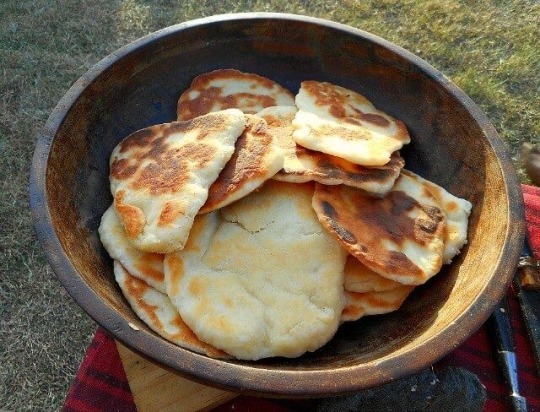
⊱ɱε∂เεѵαℓ-ƭɦყɱεร⊰
#medieval#medievaltimes#medieval times#breadcore#daily bread#bread#flatbread#medieval food#rustic#rustic food#primitive#primitive cooking
20 notes
·
View notes